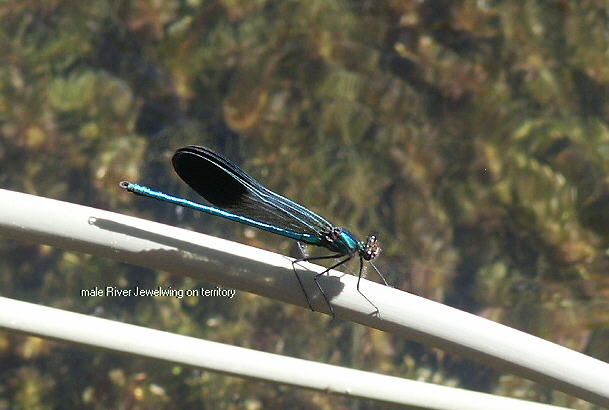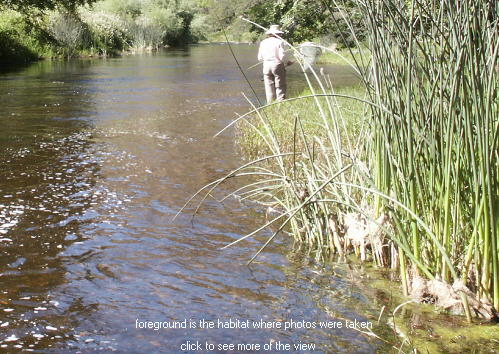River Jewelwings along the Shasta River @ Hudson Rd., 8 miles north of Yreka, Siskiyou County
These are photos taken by Dave Biggs at the Shasta River @ Hudson Rd. site
where River Jewelwings are seen each spring on May 30, 2004. We were fortunate enough to get to watch many of them,
including some fascinating behaviors.
Directions to the site, and a few site images are are available at this link.
A PDF Excel species list is available also.
Link to a map (note: scroll on the map to find Hudson Rd.,
the dark marker is NOT where the Odes are - the best viewing area is about a mile further along the road
DO NOT attempt to make the whole loop - the far end of the road where it rejoins the Hwy is badly eroded.
By just wading across the river (easily done, not much more than knee
deep although swift and with slippery rocks) and going upstream 20 ft. we
were standing alongside a tule patch that extended into the water and
just in front of it was a patch of underwater plants: elodia, I believe,
and another plant I don't know the name of, with string algae hanging in
long trails from it, as 'Spanish moss' does from oak trees. The male &
female Jewelwings were perched on the tules (and on Dave's cap several
times!), mostly within 2 ft of the water surface. The males were holding
amazingly small territories, some barely a foot square, and there were
many skirmishes with them flying around in circles and displaying their
beautiful wings. (mind you, all this is within inches to a few feet of
us, ~ 10 per site at this point)
The female and male jewelwings were mixed together on the tules.

Sometimes a male would go and do a display over his territory, but we never witnessed the moment the female thought, 'Aha, this is the site for me!', but we did get to witness several times when the male would come and 'tow' a female, dragging her along and into the surface of the water. Then, when her legs would take hold of the algae/leaves, he would let go and land nearby, presumably to defend her, while she completely submerged and crawled about underwater, ~ 1/2-2" under the surface, ovipositing into the plant matter. One such female spent the entire 20 mins we were there underwater. Sometimes her wing tips would surface, but never her body. It was amazing to watch. I wonder if she trapped oxygen with her wings?
The sun was at the perfect angle to view all this, and Dave took the photos you are seeing.
This is the spot where we stopped.
This is the view just above where the photos were taken.

This is the view of where the photos above were taken.
The Rubyspots were competing with the Jewelwings at this same site, but the males had a slightly different strategy: they would take a female in tandem and tow her along the water surface until they came to a partially submerged tule stem. He'd grab hold of the stem and then she would, he'd then release his grip and she'd back on down the tule until she reached the submerged algae/underwater plants, and then she'd start ovipositing while he stood guard. There were about ~50 River Jewelwings in this 100 yd stretch of the river.
This is one of the male American Rubyspots grooming. There were about twice
as many Rubyspots as River Jewelwings at this site.
Many Emma's Dancers were present also. They weren't in the 'competition' for sites for ovipositing, but every bit of floating dead tule leaf would support a half dozen or so ovipositing pairs, with the males in sentinel position, often having little 'fisticuffs/boxing matches' with each other due to their proximity! It was ALL lots of fun to watch.
Interesting to us too was finding several sites where we could watch Broadwing nymphs (OK, larvae) crawling about on the underwater plants and algae. All those observed appeared to be either final, or next to final instars.
At about 5 pm the Baskettails started flying beats up and down the river. We hadn't seen them before that. The Darners cruised the tules at water level the whole time. The sun shone warmly (~80 degrees) the water was clear but not cold, and all this was experienced with a Canyon Wren singing his heart out on the East side while a Chat competed with him from the West side! We think we heard the Chat try to imitate the Canyon Wren at one point. And a Song Sparrow joined in the chorus. It was a truly magical afternoon.